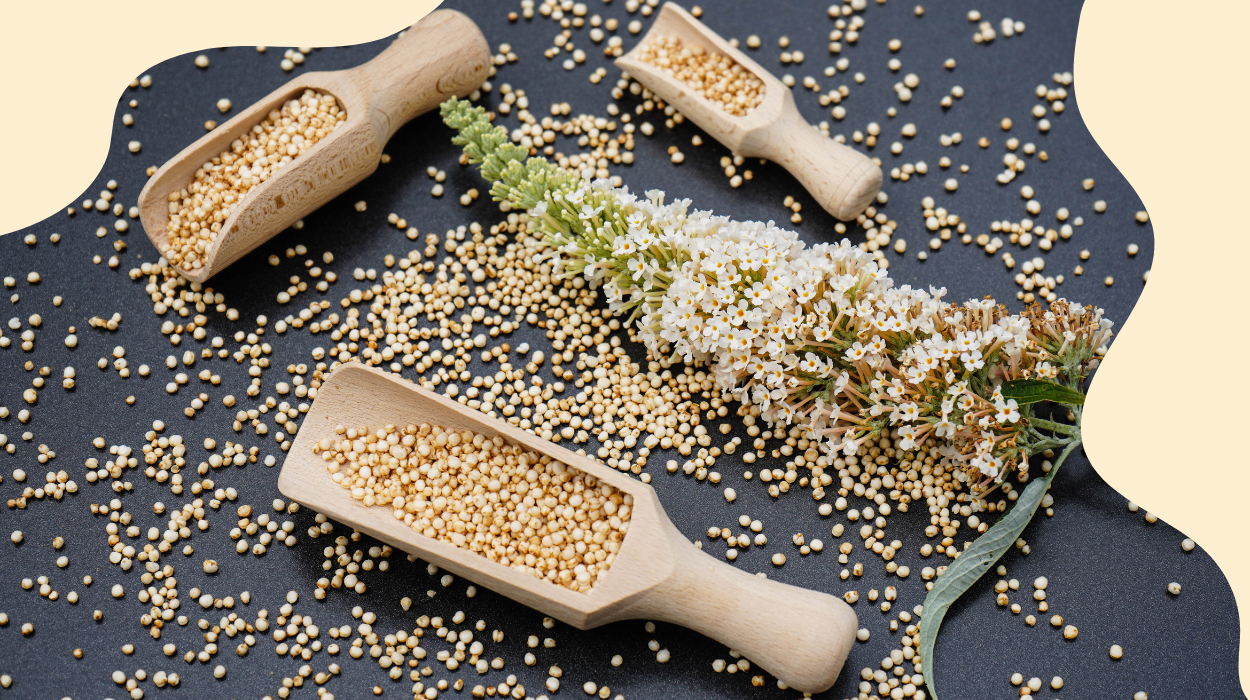Is Quinoa Paleo? Does The Paleo Diet Allow Quinoa In 2024?

The paleo diet offers an alternative eating plan for people to control the amount of sugar, salt, and processed foods while increasing the consumption of fruits and vegetables. If following this diet, it may be confusing to determine which foods to include and which to avoid, like quinoa. The Paleo diet may also make you wonder if you need a paleo supplement to help you meet your dietary needs.
Quinoa[1] is the edible seed of a plant originating from South America, where it is grown. The quinoa seeds are closely related to spinach botanically. It is called a pseudo-grain, as technically, it is a seed but appears like a grain. So with this information, you may wonder, is quinoa Paleo?
Is Quinoa Paleo-Friendly?
No, quinoa is unsuitable for the Paleo diet. Although classified as a seed, its nutrient profile behaves more like a grain. Quinoa contains less fat and protein than almonds or walnuts. Strict followers avoid quinoa due to its content of anti-nutrients like saponins. These compounds in foods may interfere with the absorption of some minerals in the body.
Quinoa Nutrition Facts
One cup of cooked quinoa[2] offers:
- 220 calories
- 8 grams of protein
- 4 grams of fat
- 39 grams of carbohydrates
- 5 grams of fiber
- 3 milligrams of iron (16% of daily value)
- 118 milligrams of magnesium (28% of daily value)
- 78 micrograms of folate (19.5% of daily value)
Quinoa seeds are a good source of energy and fiber. This pseudo-grain offers all essential amino acids, iron, calcium, vitamin A, folate, and magnesium. For this reason, quinoa has important roles in energy production, keeping us full, bone health, and the oxygenation of our bodies. Since it is gluten-free, it is an ideal alternative for those with celiac disease.
Why Should You Be Concerned About Quinoa On The Paleo Diet?
The paleo diet plan is based on the idea that our ancestors ate mainly a carnivore diet[3] during the Old Stone Age, around 2.5 million years. The main goal of this diet is to prevent disease, as the belief that modern diet is behind the increase in chronic diseases like hypertension, diabetes, and heart disease. You may wonder if quinoa should be included in the diet, as it may have been available to cavemen, but it will depend on how strictly you want to follow the paleo lifestyle.
Quinoa has an interesting classification as a pseudo-grain. Although quinoa is a seed, it appears like a grain, which is to be avoided while doing paleo. If following a strict Paleo diet, then these foods should be nixed.
The quinoa plant or chenopodium quinoa wild contains saponins. Followers of the paleo lifestyle avoid these and other pseudo grains, like amaranth, because of these anti-nutrients. Saponins[4] are compounds that protect the plant from insects. These compounds may interfere with the absorption of some nutrients, particularly minerals, in humans.
Other anti-nutrients present in quinoa are lectin and phytate. These also interfere with absorbing minerals like iron, calcium, zinc, and phosphorus. The good thing is that these compounds can be decreased or eliminated from foods by boiling them before preparing or cooking the food.
Quinoa should be avoided if following the paleo diet. It may seem overwhelming since many other foods are to be limited or avoided, but you can find this diet satisfying.
Benefits Of The Paleo Diet
Short-term studies reveal that the paleo diet might help[5] with the following in those with diabetes:
- Balances blood glucose levels.
- Lowered cholesterol and triglycerides.
- Lowered risk of heart disease, and
- Possible weight loss[6] in healthy individuals.
This diet, in particular, may offer the benefit of allowing you to get in tune with foods with less processing. It also may offer the opportunity to lean out while working out. If following this diet, use this opportunity to learn new ways to enjoy fruits and vegetables.
Paleo-Friendly Quinoa Substitutes
If you are following the paleo diet plan, you may wonder if there are alternatives to its use. Thinking back on how quinoa is usually consumed as an alternative to rice or grain. It can also make a great salad or top your salads to add nutrients. You can create your meal plan and find a paleo-friendly option for your favorite recipes.
Try preparing cauliflower or broccoli rice dishes in paleo recipes using riced vegetables as an alternative to the grain. I can make riced vegetables from various veggies such as beets, broccoli, sweet potatoes, cauliflower, etc. Make your stir-fry, “rice bowls,” or soups.
Quinoa can add texture to your salads. As an alternative, mix nuts (sliced almonds, pistachios, walnuts) or seeds (sunflower seeds, flax, and chia) into your salads as a protein, fiber, and healthy fat source.
Use zucchini noodles or spaghetti squash noodles as an alternative to pasta. You can buy these frozen or grate them fresh with your spiralizer. You can then cook and mix with pesto or stir-fry with your favorite vegetables.
If looking for sweet treats, consider a mixed fruit bowl and top it with your favorite nuts or coconut.
Most of these alternatives are lower calorie, provide satiety, and support your weight loss goals.
Other Foods To Avoid On The Paleo Diet
The paleo diet, or caveman diet, eliminates many foods believed not to be available for hunter-gatherers. It mainly focuses on fresh fruits, vegetables, meats, and nuts.
People who are interested in following the paleo diet should familiarize themselves with foods that are included and exclude the following:
- Avoid all grains and cereals: Brown rice, white rice, corn, quinoa, oats, barley, couscous, polenta, pasta, noodles, bread, and cereals.
- Exclude dairy and products: Milk, cheese, and yogurt.
- Avoid legumes: These include beans, lentils, edamame, and peanuts.
- Limit alcoholic beverages. Avoid coffee, tea, and juices. Consume mainly water for hydration.
- Avoid processed foods, sugar, and sweeteners.
- Limit oils and fats.
It may be beneficial to note that this diet excludes full food groups[7] and may not be an adequate diet for all individuals. In addition, you may need calcium supplementation due to eliminating dairy. You can also include vegetables like broccoli which offer calcium.
The Bottom Line
If you are following a Paleolithic diet, you may need to avoid quinoa. You can eat quinoa as a transitional food when starting paleo. This way, it won’t feel like you are cutting all grains cold turkey, allowing you to ease yourself into the full diet. Otherwise, quinoa is not part of the strictest following of the paleo lifestyle.
+ 7 sources
Health Canal avoids using tertiary references. We have strict sourcing guidelines and rely on peer-reviewed studies, academic researches from medical associations and institutions. To ensure the accuracy of articles in Health Canal, you can read more about the editorial process here
- The Nutrition Source. (2017). Quinoa. [online] Available at: https://www.hsph.harvard.edu/nutritionsource/food-features/quinoa/
- Usda.gov. (2023). FoodData Central. [online] Available at: https://fdc.nal.usda.gov/fdc-app.html#/food-details/168917/nutrients
- Pitt CE (2016). Cutting through the Paleo hype: The evidence for the Palaeolithic diet. Australian family physician, [online] 45(1). Available at: https://pubmed.ncbi.nlm.nih.gov/27051985/
- Sharma, K., Kaur, R., Kumar, S., Ramesh Kumar Saini, Sharma, S., Pawde, S.V. and Kumar, V. (2023). Saponins: A concise review on food related aspects, applications and health implications. [online] 2, pp.100191–100191. doi:https://doi.org/10.1016/j.focha.2023.100191.
- Umesh Masharani, P Sherchan, Schloetter, M., Stratford, S., Xiao, A., Sebastian, A., M Nolte Kennedy and Frassetto, L.A. (2015). Metabolic and physiologic effects from consuming a hunter-gatherer (Paleolithic)-type diet in type 2 diabetes. [online] 69(8), pp.944–948. doi:https://doi.org/10.1038/ejcn.2015.39.
- Genoni, A., Philippa Lyons-Wall, Lo, J. and Devine, A. (2016). Cardiovascular, Metabolic Effects and Dietary Composition of Ad-Libitum Paleolithic vs. Australian Guide to Healthy Eating Diets: A 4-Week Randomised Trial. [online] 8(5), pp.314–314. doi:https://doi.org/10.3390/nu8050314.
- Tahreem, A., Allah Rakha, Roshina Rabail, Nazir, A., Socol, C., C. Maerescu and Rana Muhammad Aadil (2022). Fad Diets: Facts and Fiction. [online] 9. doi:https://doi.org/10.3389/fnut.2022.960922.



